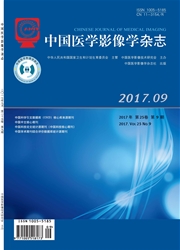

 中文摘要:
中文摘要:
目的探讨乳腺良恶性病变剪切波弹性模量及胶原纤维含量的差异,分析乳腺病变剪切波弹性模量与胶原纤维的相关性。资料与方法对解放军总医院的116例拟进行手术或穿刺活检的乳腺病变患者进行剪切波弹性检查,并对手术或穿刺活检病理标本行Van Gieson(VG)染色,采用Image-Pro Plus 5.1软件进行胶原纤维的定量分析。结果乳腺恶性病变弹性模量最大值、平均值及病灶与周围组织弹性模量比值(140.43±70.16)kPa、(63.11±33.68)kPa、3.49±1.95明显高于良性病变的(54.64±48.53)kPa、(34.52±25.23)kPa、2.25±1.48(t=5.329、4.382、4.487,P〈0.01)。恶性病变胶原纤维面积明显大于良性病变(t=8.437,P〈0.01)。弹性模量最大值与胶原纤维含量呈线性正相关(r=0.746,P〈0.05)。结论乳腺病变的弹性模量与胶原纤维含量密切相关,胶原纤维在乳腺癌的发生发展过程中可能发挥重要作用。
 英文摘要:
英文摘要:
Purpose To study the differences of shear wave elasticity and the content of collagen fiber between benign breast lesions and malignant breast lesions, and to analyze the correlation between shear wave elasticity and the content of collagen fiber. Materials and Methods 106 patients with 116 breast lesions who were referred to PLA General Hospital for ultrasound-guided biopsy or surgery underwent shear wave elasticity examination, the biopsy specimen underwent Van Gieson(VG) dye and ImagePro Plus 5.1 software was used to quantitatively analyze the content of collagen fiber. Results Malignant lesions exhibited significantly higher max elasticity, mean elasticity, and elasticity ratio between lesions and surrounding parenchyma(140.43±70.16) kPa,(63.11±33.68) kPa, 3.49±1.95 than benign lesions(54.64±48.53) kPa,(34.52±25.23) kPa, 2.25±1.48(t=5.329, 4.382 and 4.487, P0.01). The content of collagen fiber of malignant lesions was significantly higher than that of benign lesions(t=8.437, P0.01). There was a positive correlation between max elasticity and the content of fiber collagen(r=0.746, P0.05). Conclusion The elasticity of breast lesions has a close correlation with the content of collagen fiber, and collagen fiber might play an important role in the development of breast carcinoma.
 同期刊论文项目
同期刊论文项目
 同项目期刊论文
同项目期刊论文
 期刊信息
期刊信息
